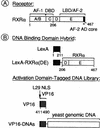The yeast Ada complex mediates the ligand-dependent activation function AF-2 of retinoid X and estrogen receptors
- PMID: 9573045
- PMCID: PMC316789
- DOI: 10.1101/gad.12.9.1278
The yeast Ada complex mediates the ligand-dependent activation function AF-2 of retinoid X and estrogen receptors
Abstract
Nuclear receptors can function as ligand-inducible transregulators in both mammalian and yeast cells, indicating that important features of control of transcription have been conserved throughout evolution. Here, we report the isolation and characterization of a yeast protein that exhibits properties expected for a coactivator/mediator of the ligand-dependent activation function AF-2 present in the ligand-binding domain (LBD, region E) of the retinoid X (RXRalpha) and estrogen (ERalpha) receptors. This protein is identical to Ada3, a component of the yeast Ada coactivator complex. We demonstrate that: (1) the region encompassing residues 347-702 of Ada3 interacts with the LBD of RXRalpha and ERalpha in a ligand-dependent manner in yeast; (2) this interaction corresponds to a direct binding and requires the integrity of the core of the AF-2 activating domain (AF-2 AD) of both RXRalpha and ERalpha; (3) Ada3 as well as Ada2 and Gcn5, two other components of the Ada complex, are required for maximal AF-2 activity in yeast; and (4) Ada3 is able to enhance the AF-2 activity of RXRalpha and ERalpha when overexpressed in yeast and mammalian cells. Taken together, these data indicate that ligand-dependent transactivation by RXRalpha and ERalpha in yeast is mediated at least in part by the Ada complex, in which the Ada3 subunit directly binds to the holoreceptor LBD.
Figures










Similar articles
-
Role of the essential yeast protein PSU1 in p6anscriptional enhancement by the ligand-dependent activation function AF-2 of nuclear receptors.EMBO J. 1999 Apr 15;18(8):2229-40. doi: 10.1093/emboj/18.8.2229. EMBO J. 1999. PMID: 10205176 Free PMC article.
-
Differential ligand-dependent interactions between the AF-2 activating domain of nuclear receptors and the putative transcriptional intermediary factors mSUG1 and TIF1.EMBO J. 1996 Jan 2;15(1):110-24. EMBO J. 1996. PMID: 8598193 Free PMC article.
-
Differential modulation of transcriptional activity of oestrogen receptors by direct protein-protein interactions with retinoid receptors.Biochem J. 1998 Dec 15;336 ( Pt 3)(Pt 3):711-7. doi: 10.1042/bj3360711. Biochem J. 1998. PMID: 9841885 Free PMC article.
-
Ligand-dependent interaction of nuclear receptors with potential transcriptional intermediary factors (mediators).Philos Trans R Soc Lond B Biol Sci. 1996 Apr 29;351(1339):569-78. doi: 10.1098/rstb.1996.0056. Philos Trans R Soc Lond B Biol Sci. 1996. PMID: 8735280 Review.
-
Yeast two-hybrid screening for proteins that interact with nuclear hormone receptors.Methods Mol Biol. 2001;176:227-48. doi: 10.1385/1-59259-115-9:227. Methods Mol Biol. 2001. PMID: 11554324 Review. No abstract available.
Cited by
-
The human TFIID components TAF(II)135 and TAF(II)20 and the yeast SAGA components ADA1 and TAF(II)68 heterodimerize to form histone-like pairs.Mol Cell Biol. 2000 Jan;20(1):340-51. doi: 10.1128/MCB.20.1.340-351.2000. Mol Cell Biol. 2000. PMID: 10594036 Free PMC article.
-
Altered nuclear cofactor switching in retinoic-resistant variants of the PML-RARα oncoprotein of acute promyelocytic leukemia.Proteins. 2012 Apr;80(4):1095-109. doi: 10.1002/prot.24010. Epub 2012 Jan 7. Proteins. 2012. PMID: 22228505 Free PMC article.
-
Human papillomavirus oncoprotein E6 inactivates the transcriptional coactivator human ADA3.Mol Cell Biol. 2002 Aug;22(16):5801-12. doi: 10.1128/MCB.22.16.5801-5812.2002. Mol Cell Biol. 2002. PMID: 12138191 Free PMC article.
-
The nuclear receptor 4A family members: mediators in human disease and autophagy.Cell Mol Biol Lett. 2020 Nov 3;25(1):48. doi: 10.1186/s11658-020-00241-w. Cell Mol Biol Lett. 2020. PMID: 33292165 Free PMC article. Review.
-
Human ADA3 regulates RARalpha transcriptional activity through direct contact between LxxLL motifs and the receptor coactivator pocket.Nucleic Acids Res. 2010 Sep;38(16):5291-303. doi: 10.1093/nar/gkq269. Epub 2010 Apr 22. Nucleic Acids Res. 2010. PMID: 20413580 Free PMC article.
References
-
- Ayer DE, Lawrence QA, Eisenman RN. Mad–Max transcriptional repression is mediated by ternary complex formation with mammalian homologs of yeast repressor Sin3. Cell. 1995;80:767–776. - PubMed
-
- Baniahmad C, Nawaz Z, Baniahmad A, Gleeson MA, Tsai MJ, O’Malley BW. Enhancement of human estrogen receptor activity by SPT6: A potential coactivator. Mol Endocrinol. 1995;9:34–43. - PubMed
-
- Barlev NA, Candau R, Wang L, Darpino P, Silverman N, Berger SL. Characterization of physical interactions of the putative transcriptional adaptor, ADA2, with acidic activation domains and TATA-binding protein. J Biol Chem. 1995;270:19337–19344. - PubMed
-
- Brownell JE, Zhou J, Ranalli T, Kobayashi R, Edmondson DG, Roth SY, Allis CD. Tetrahymena histone acetyltransferase A: A homolog to yeast Gcn5p linking histone acetylation to gene activation. Cell. 1996;84:843–851. - PubMed
Publication types
MeSH terms
Substances
LinkOut - more resources
Full Text Sources
Molecular Biology Databases
Research Materials
